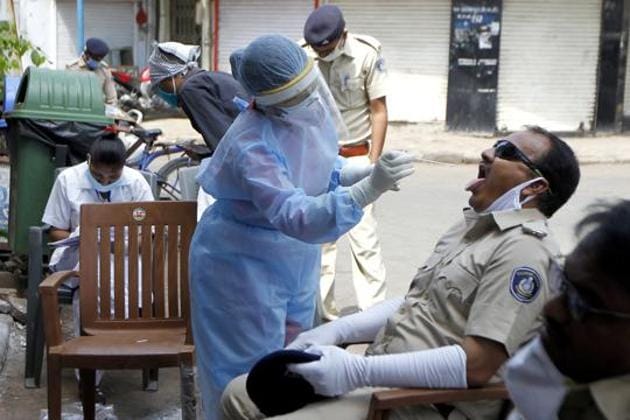Covid-19: The unmaking of the Gujarat model
Its limited investment in public health has come back to haunt the state. Focus on the social sector now
The much-hyped Gujarat model is in a mess as the coronavirus pandemic progresses. Consider the following: One, not only does the state have among the highest number of coronavirus disease (Covid-19) cases in the country, but more worryingly, it has a mortality rate of 5.9%, which is nearly twice the national average of 3.09%.

Two, the Ahmedabad municipal commissioner, a well-regarded Indian Administrative Service officer, is suddenly removed because, according to media reports, the government felt he was “testing too much”. Three, a national daily reports that an Ahmedabad hospital was segregating Covid-19 patients on religious lines. The government denies it even as chief minister (CM) Vijay Rupani blames the Tablighi Jamaat for the spurt in cases. Four, in Surat, migrant workers clashed with the police on several occasions in the past month. Five, in Rajkot, a TV journalist is injured when a mob of migrant labour, incensed that their train has been cancelled, vented their ire on the local media even as the police stood by helplessly. Six, a Gujarati website journalist is booked for sedition for reporting that there are problems between Rupani and the Bharatiya Janata Party high command.
So what has gone wrong in a state that is branded as a model for 21st century India, one whose rapid development was seen as the cornerstone for Prime Minister Narendra Modi’s rise to national prominence and eventually the prime ministership?
The truth is that the “Gujarat model” was never the wondrous paradise that the glitzy propaganda machine suggested it to be for more than a decade between 2001 and 2014. The “Vibrant Gujarat” imagery, which saw hundreds of Memorandums of Understanding being signed between industrialists and the government, was only one part of the story. While the state successfully cultivated a business-friendly image and took impressive strides in building up its physical infrastructure — roads, ports, power generation — and significantly enhanced its agricultural growth rate, the areas of darkness were obscured and never questioned by a mostly pliant media and citizenry. One of those dark spots has now come to haunt the model — its failure to address public health care concerns and build a socially-inclusive system of governance.
Gujarat has 0.33 hospital beds per 1,000 population as against the national average of 0.55 beds per 1,000. Among the large states, only Bihar has a worse ratio. In terms of per capita health expenditure, Gujarat slipped from fourth in 1999-2000 to 11th position in 2009-10, with health expenditure as a percentage of Net State Domestic Product declining from 0.87% to 0.73% in this decade. Its infant mortality rates remain worryingly high, another reflection of poor social sector spending. Sanjeev Kumar, a researcher at Tata Institute of Social Sciences, reveals that the total number of primary health centres in Gujarat is less than even Bihar and the latter has almost three times as many rural public hospitals as Gujarat. Several government hospitals have been handed over to the private sector in recent years.
The failure to build a robust public health infrastructure is matched by a decline in investment in education. Gujarat spends less than 2% of its income on education and nearly 45% of its workforce are illiterate or have studied up to the fifth standard. Poor quality higher education has meant a growing number of unemployed engineers and science graduates. Ahmedabad-based economist Indira Hirway has pointed out that over 90% of workers are in informal and traditional sectors with low incomes and low social security; the state also has among the lowest wage rates among the major states in the country. Should the angst of migrant labourers working in Surat’s grimy underbelly of squalor come as any surprise?
Nor should it come as a surprise that those who have sought a reset of priorities or questioned the political authority are being ostracised or charged with sedition. Centralisation of power allows for no dissent. This is not the first time that journalists have been charged with sedition for criticising the government. The CM’s attempt to pin the blame on the Tablighis is also predictable. For years, the political establishment has nurtured a dislike for minority groups. The Tablighis provided the perfect alibi for a government struggling to control the spread of the virus.
The coronavirus crisis is a wake-up call for Gujarat, a state riding high on its entrepreneurial zeal and aspirational dreams, but also a state blighted by stark caste and communal divisions and rising income disparities. The Modi years have seen a fierce assertion of Gujarati asmita (regional pride), but have also witnessed the marginalisation of those social groups which did not buy into the “Vibrant Gujarat” messaging. The coronavirus challenge provides Gujarat with an opportunity to revive some of its lost Gandhian values of compassion; an inclusive community spirit, one which doesn’t just take pride in increased capital investment, but also in enhancing its human development. That would be the true Gujarat model to strive for.
Post-script: In February, the Ahmedabad municipal authorities courted controversy when overnight a wall was built to apparently hide the slums of the city from the gaze of the much-publicised United States presidential visit. It has now taken a coronavirus for the city’s beautification drive to be confronted with a more ugly reality.






